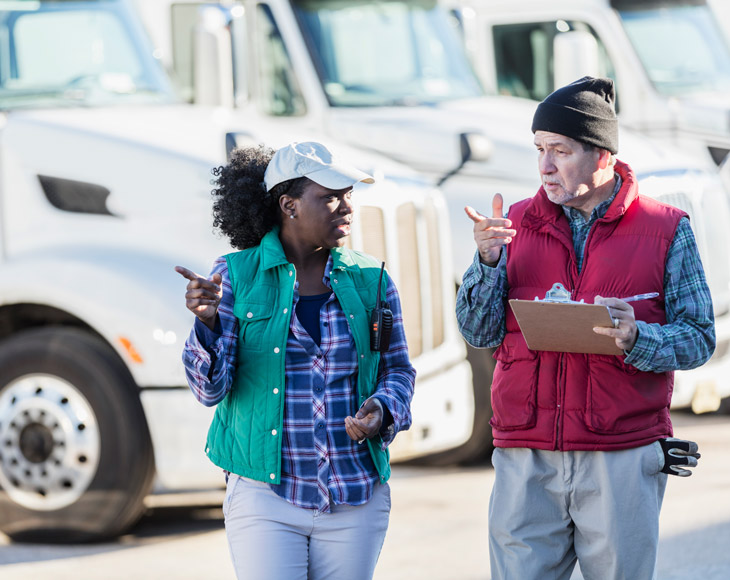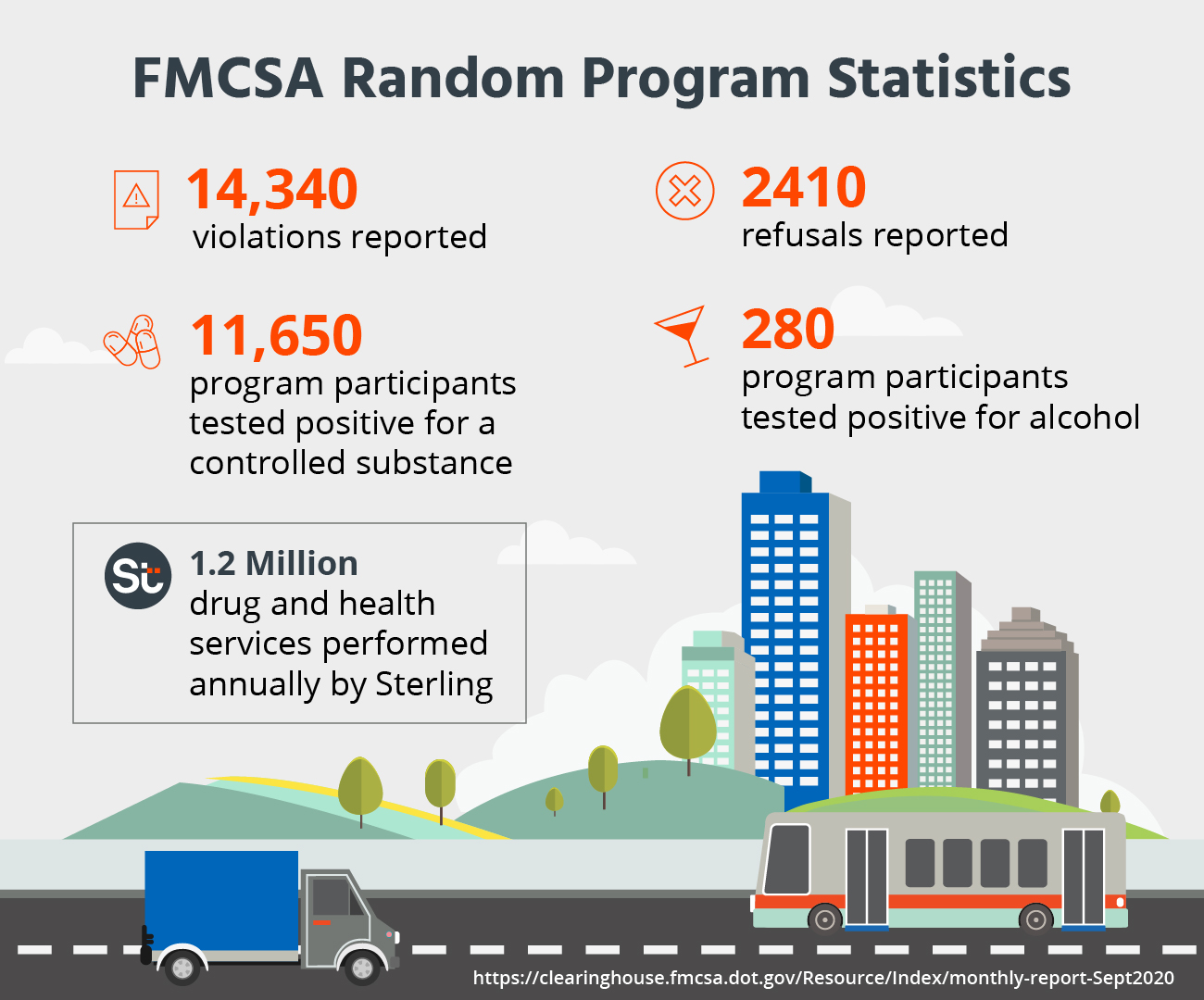November 23rd, 2020 | Nicholas Herstich, Product Leader, Sterling Industrials, Government, and Education
End of Year To-Do List: Key Actions Needed Within Transportation

It’s safe to say that 2020 wasn’t the year anyone expected. Looking back to late 2019 with the onset of the FMCSA (Federal Motor Carrier Safety Administration) Clearinghouse imminently approaching, many anticipated that new regulation would be one of the most significant elements of 2020 in the transportation industry.
With Covid-19, the FMCSA declared a national emergency for the first time in history and provided some regulatory relief around Hours of Service (HOS), vehicle maintenance and inspection, and Third Party Commercial Driver’s License (CDL) skill testing to help ease select regulations on those transporting and delivering essential goods. While there is hope that conditions will return to some sort of normalcy over the next several months, the FMCSA will soon decide whether these waivers should continue based on data and input from key stakeholders. As 2020 closes, this is an ideal opportunity to consider some of the FMCSA end-of-year requirements and look at FMCSA initiatives that are on the horizon.
Have you run the required annual queries yet? If not, Sterling can help
In a continuous effort to make our nation’s roadways safer for all drivers, the FMCSA officially launched the Drug and Alcohol Clearinghouse database on January 6, 2020. This electronic repository, along with the FMCSA-regulated previous employer check, is required under Part 391.23. Once three years of violation data is stored in the Clearinghouse, the previous employer checks will no longer be needed and the Full Query of the Clearinghouse by the employer will satisfy that requirement.
Additionally, employers must conduct a query of the Clearinghouse at least once per year for all covered current employees to determine whether violation information exists. Most employers will opt to leverage the Limited Query and paper consent process to meet the annual requirement because it does not require the employee to log into the Clearinghouse. If any pertinent information is found during the annual Limited Query, a Full Query must be run within 24 hours to obtain complete information.
Details on FMCSA Clearinghouse regulations may be accessed at § 382.701
Sterling is registered as a Consortium/Third Party Administrator (C/TPA) to help support FMCSA regulated employers with the Clearinghouse. Clients are also able to utilize our world-class technology and candidate experience, which makes the ordering process simple and streamlined. Sterling’s bulk order tool can assist with running both full- and limited-batch queries in a quick and convenient way to assist you with meeting the annual requirement by the January 5, 2021 deadline.

The clock is ticking to comply with annual MVR requirements
Like the annual requirement to query the Clearinghouse for all covered employees, employers must also run a Motor Vehicle Record (MVR) at least once every 12 months, covering at least the preceding 12 months, in every state a driver held a license during that period. It is also important to note that not only must an MVR be run, but an annual review of the employee’s driving record must be performed by the employer.
Both a copy of the MVR and a note of the person who performed the review must be maintained in the Driver Qualification File (DQF). The review should consider things like violations of FMCSA regulations, accidents, and moving violations. Considerable weight should be placed on items that indicate the driver has exhibited a disregard for public safety like speeding, reckless driving, and operating a vehicle under the influence of drugs or alcohol.
Drivers are also required to submit a list of all violations of convictions for violations of motor vehicle traffic laws and ordinances within the preceding 12 months to their employer/motor carrier. This list must also be maintained in the DQF. If a driver had previously reported the violation as part of the 30-day reporting requirement in § 383.31, they need not repeat that information on the annual list of violations.
Detailed Annual MVR and Review of Driving Record regulations may be accessed at § 391.25 and § 391.27
Sterling’s technology and bulk order tool alleviates some of the administrative burden from your organization. By simply uploading a driver employee template into Sterling’s platform, a client can quickly run anywhere from a few dozen to tens of thousands of drivers at once. Many clients have successfully adopted Sterling’s recommendation to package the Annual MVR and the Limited Query together to meet the annual requirements for both in one order.
Catch up on your random testing rates before it’s too late
The year 2020 also saw FMCSA random testing rates for controlled substances increase from 25% to 50%. While the 2021 testing rates won’t be released until sometime in December, § 382.305 specifies that data must be received for two consecutive years that indicate a positive rate of less than 1% before the controlled substance rates can be reduced back to 25%.
With the end of the year quickly approaching, it’s critical to make sure that your random pools are up to date and testing rates have been met throughout the year. If there is risk of falling short of the 50% controlled substance and 10% alcohol testing requirements, it’s imperative that you catch up between now and the end of 2020. To calculate the total number of covered drivers eligible for random testing throughout the year, as an employer, you must add the total number of covered drivers eligible for testing during each random testing period for the year and divide that total by the number of random testing periods. All FMCSA-covered drivers must be included in the employer’s random pool if safety-sensitive functions are being performed or could be performed during the random testing period.
Details on Department of Transportation (DOT) Random Program regulations may be accessed at § 382.305
Sterling is a certified C/TPA, and our random selection process utilizes computer-based, unbiased selections to meet the most stringent federal standards. Sterling can also help clients with their random drug testing program by providing reports through assigned administrators working with you on a regular basis. In addition, clients have access to view pending random selections on our platform throughout the course of the random testing period and also view test results.

Stay ahead of the curve
In one way or another, the FMCSA has acknowledged driver shortages, high turnover rates, the aging fleet of CDL drivers, and the need to modernize processes. Part of the future initiatives includes pilot programs and various committees to help address some of these pitfalls.
We recently saw new Department of Health and Human Services rules authorizing use of oral fluid sampling for federal testing programs. While oral fluid sampling is not yet authorized for pre-hire or post-hire DOT testing, the new Federal Chain of Custody Form (CCF) has been authorized. Its use is mandated for all pre-hire and post-hire DOT testing no later than September 1, 2021. This anticipates DOT authorization for oral fluid sampling by the September 1, 2021 mandate, but is not certain until rules are finalized. Until that time, current Federal CCF is permitted.
Authorization for hair sampling is also expected to follow DOT approval of oral fluid sampling. Sterling will continue to keep our clients informed as developments occur to best support all planning and preparation efforts.
Other programs the FMCSA has launched or is considering include:
- Entry-Level Driver Training (ELDT), which looks to bolster and standardize training requirements for CDL drivers looking to obtain or upgrade their endorsement. Due to technology issues with state licensing agencies, the ELDT requirements have been pushed to February 7, 2022.
- Under-21 Military CDL Pilot. In 2019, the FMCSA kicked of a program allowing certain military drivers between the ages of 18 and 20 to obtain a CDL. Low adoption rates have the FMCSA exploring other options to help promote this program. FMCSA is also considering an under-21 non-military pilot.
The FMCSA has also announced intention to study and potentially revise rule making around automated crash avoidance technology, like lane assist and automated emergency braking systems. Additionally, comments by the FMCSA at the recent American Trucking Association (ATA) conference were made about the inevitable likelihood of autonomous driving vehicles and safety rules that would need to be considered.
It’s important to note that in FY2019 the FMCSA opened nearly 4,000 cases against carriers and bus companies for non-compliance with the Federal Motor Carrier Safety Regulations (FMCSRs). These violations cost carriers a staggering $27.5million in civil penalties. Through both our transportation-focused client support model and technology, Sterling partners with its regulated clients to help enable FMCSA compliance across all aspects of their program.
Read more about why Sterling is recognized as a leader in screening services and how our suite of Transportation Industry services can address your needs.
This publication is for informational purposes only and nothing contained in it should be construed as legal advice. We expressly disclaim any warranty or responsibility for damages arising out this information. We encourage you to consult with legal counsel regarding your specific needs. We do not undertake any duty to update previously posted materials.
This content is offered for informational purposes only. First Advantage is not a law firm, and this content does not, and is not intended to, constitute legal advice. Information in this may not constitute the most up-to-date legal or other information.
Readers of this content should contact their attorney or lawyer to obtain advice concerning any particular legal matter. No reader, or user of this content, should act or refrain from acting on the basis of information in this content without first seeking legal advice from counsel or lawyers in the relevant jurisdiction. Only your individual attorney or legal advisor can provide assurances that the information contained herein – and your interpretation of it – is applicable or appropriate to your particular situation. Use of, and access to, this content does not create an attorney-client relationship between the reader, or user of this presentation and First Advantage.

